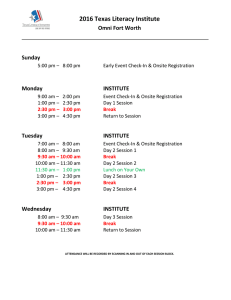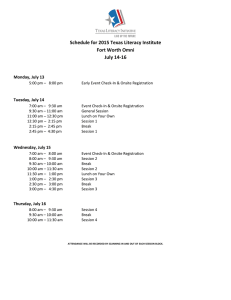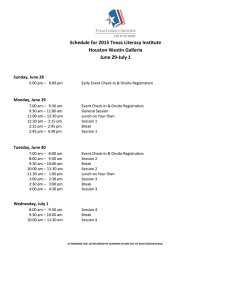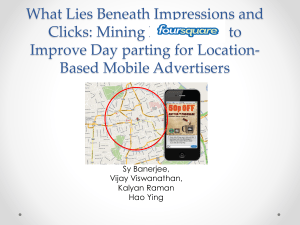Location : How Users Share and Respond to
advertisement
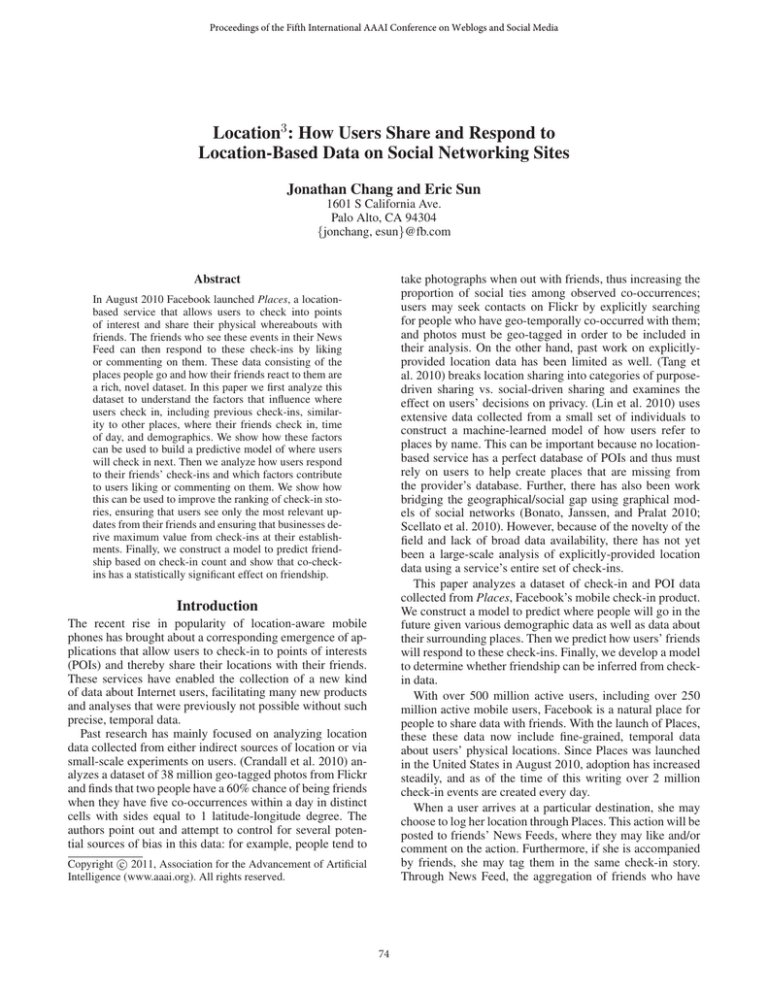
Proceedings of the Fifth International AAAI Conference on Weblogs and Social Media
Location3 : How Users Share and Respond to
Location-Based Data on Social Networking Sites
Jonathan Chang and Eric Sun
1601 S California Ave.
Palo Alto, CA 94304
{jonchang, esun}@fb.com
take photographs when out with friends, thus increasing the
proportion of social ties among observed co-occurrences;
users may seek contacts on Flickr by explicitly searching
for people who have geo-temporally co-occurred with them;
and photos must be geo-tagged in order to be included in
their analysis. On the other hand, past work on explicitlyprovided location data has been limited as well. (Tang et
al. 2010) breaks location sharing into categories of purposedriven sharing vs. social-driven sharing and examines the
effect on users’ decisions on privacy. (Lin et al. 2010) uses
extensive data collected from a small set of individuals to
construct a machine-learned model of how users refer to
places by name. This can be important because no locationbased service has a perfect database of POIs and thus must
rely on users to help create places that are missing from
the provider’s database. Further, there has also been work
bridging the geographical/social gap using graphical models of social networks (Bonato, Janssen, and Pralat 2010;
Scellato et al. 2010). However, because of the novelty of the
field and lack of broad data availability, there has not yet
been a large-scale analysis of explicitly-provided location
data using a service’s entire set of check-ins.
This paper analyzes a dataset of check-in and POI data
collected from Places, Facebook’s mobile check-in product.
We construct a model to predict where people will go in the
future given various demographic data as well as data about
their surrounding places. Then we predict how users’ friends
will respond to these check-ins. Finally, we develop a model
to determine whether friendship can be inferred from checkin data.
With over 500 million active users, including over 250
million active mobile users, Facebook is a natural place for
people to share data with friends. With the launch of Places,
these these data now include fine-grained, temporal data
about users’ physical locations. Since Places was launched
in the United States in August 2010, adoption has increased
steadily, and as of the time of this writing over 2 million
check-in events are created every day.
When a user arrives at a particular destination, she may
choose to log her location through Places. This action will be
posted to friends’ News Feeds, where they may like and/or
comment on the action. Furthermore, if she is accompanied
by friends, she may tag them in the same check-in story.
Through News Feed, the aggregation of friends who have
Abstract
In August 2010 Facebook launched Places, a locationbased service that allows users to check into points
of interest and share their physical whereabouts with
friends. The friends who see these events in their News
Feed can then respond to these check-ins by liking
or commenting on them. These data consisting of the
places people go and how their friends react to them are
a rich, novel dataset. In this paper we first analyze this
dataset to understand the factors that influence where
users check in, including previous check-ins, similarity to other places, where their friends check in, time
of day, and demographics. We show how these factors
can be used to build a predictive model of where users
will check in next. Then we analyze how users respond
to their friends’ check-ins and which factors contribute
to users liking or commenting on them. We show how
this can be used to improve the ranking of check-in stories, ensuring that users see only the most relevant updates from their friends and ensuring that businesses derive maximum value from check-ins at their establishments. Finally, we construct a model to predict friendship based on check-in count and show that co-checkins has a statistically significant effect on friendship.
Introduction
The recent rise in popularity of location-aware mobile
phones has brought about a corresponding emergence of applications that allow users to check-in to points of interests
(POIs) and thereby share their locations with their friends.
These services have enabled the collection of a new kind
of data about Internet users, facilitating many new products
and analyses that were previously not possible without such
precise, temporal data.
Past research has mainly focused on analyzing location
data collected from either indirect sources of location or via
small-scale experiments on users. (Crandall et al. 2010) analyzes a dataset of 38 million geo-tagged photos from Flickr
and finds that two people have a 60% chance of being friends
when they have five co-occurrences within a day in distinct
cells with sides equal to 1 latitude-longitude degree. The
authors point out and attempt to control for several potential sources of bias in this data: for example, people tend to
c 2011, Association for the Advancement of Artificial
Copyright Intelligence (www.aaai.org). All rights reserved.
74
nearby places, and people who have checked into these
places. Predicting where a user will check into next can drive
applications such how to rank places on users’ mobile devices, to suggest new places for users to check into, or to
provide businesses with ad-targeting data. Additionally, it
yields insights into how users check into places and complements traditional places analytics.
We describe the features used to make predictions in the
first subsection along with their descriptive statistics. We
then present the model and its performance on the dataset.
Features
Figure 1: Heatmap of check-ins in San Francisco, California.
Brighter shading denotes areas of higher check-in activity.
Our model generates the probability of checking into a place
give the following features:
checked in to the same location into a single story provides
organized information about friends’ whereabouts and activities. In addition, Places allows friends who are in close
physical proximity to make unexpected and serendipitous
in-person connections.
Although only a small percentage of Facebook users are
active users of Places, the global reach and popularity of
Facebook means that there are sufficient data to make powerful, general predictions of where people will go, how their
friends will respond, and how people relate to one another.
The results of this analysis may help businesses target deals
and advertisements to users of location-based services such
as Facebook Places that frequent their establishments as well
as their friends. Furthermore, the unique time component of
check-in data has powerful implications for mobile advertising: in addition to targeting demographics, the predictions
suggested by this analysis also target time and create small
and valuable temporal windows for potential customers. For
example, advertisements may be targeted to be redeemed in
the next few hours as opposed to being available for the next
week. As a result, the benefit to users is that advertising can
truly be catered to their needs. This benefit extends beyond
businesses to local activities and special events. The timeliness of a particular advertisement based on where users and
their friends may be represents a new level of relevance of
information.
Previous check-ins The number of times the user has previously checked into the place, along with the total number
of times the place has been checked into by all users.
Friend check-ins The number of times any of the user’s
friends has checked into the place.
Demographic data The number of times people of the
user’s age and gender have checked into the place. For example, Figure 2 shows heatmaps of where males and females
are especially likely to check in (that is, where the checkin probability of that gender divided by the check-in probability of both genders is large). Places in the Castro neighborhood have an unusually high number of check-ins from
males, while females tend to check into the Union Square
neighborhood.
Time of Day The number of times users have checked into
each place at each hour of the day and day of the week.
Figure 3 shows heatmaps of where users of the product are
likely to check in in the morning (6 A.M. to 10 A.M.) versus
the evening (8 P.M. to midnight).
User membership in a low-dimensional representation of
the place space Latent Dirichlet allocation (LDA) (Blei,
Ng, and Jordan 2003) is a mixed-membership model which
has been successfully used to detect patterns and clusters
in text. It presumes data that consist of a set of documents,
each of which contains an unordered set of words, and finds
a set of topics, sets of words which tend to co-occur. It also
assigns to each document a vector representing how much
each document participates in each topic. This model is depicted in Figure 4.
For our application we consider each user a “document”
and the set of places a user has checked into as its “words.”
Thus LDA gives us groupings of places which tend to occur
(topics), and assigns to each user a vector indicating how
often they check into places in each topic. We use this latter
vector as a feature for our model.
Note that unlike the clustering used in (Cranshaw and
Yano 2010) to find neighborhoods, our approach here uses
Data
In order to do a deep examination of location interactions,
we consider all points of interest in the Facebook Places
database within the boundaries of San Francisco, California
as of January 31, 2011. In the analyses that follow, all data
were analyzed in aggregate, and no personally-identifiable
information was used. The dataset was further split into a
training set ending on January 24, 2011; the balance was
used as a test set. Figure 1 is a heatmap depicting the checkins in our dataset. Brighter areas represent regions with a
higher incidence of check-ins.
Predicting Where People Will Go
In this section, we address the problem of predicting where
a user will check into next, given information about users,
75
(a) male
(a) 6 A.M. to 10 A.M.
(b) female
(b) 8 P.M. to midnight
Figure 2: Heatmaps of check-ins broken down by gender.
Brighter shading denotes areas of higher check-in activity.
Figure 3: Heatmaps of check-ins broken down by time of
day. Brighter shading denotes areas of higher check-in activity.
the co-check-in as the unit of clustering rather than colocation. However, the clusters found in our approach often do correspond to conceptual neighborhoods. Table 1
shows a few of the topics inferred by the approach. The first
two topics correspond clearly to neighborhoods (the Castro and the Marina). The last contains geographically dispersed places (the Richmond, Sunset, and Chinatown neighborhoods) which all have high Asian-American populations.
Thus, this approach has the potential to find culturally similar “neighborhoods” even if they span different areas of a
city.
user’s usual location whence he or she uses Facebook.
Distance of place to user’s previous check-ins We use kmeans clustering on the user’s previous check-ins. We then
use as a feature the distance between the place and the closest cluster center for each user. Figure 5 shows the centers
k-means produces for a typical user. Empirically, the centers
are often associated with neighborhoods in San Francisco,
such as the Mission, the Marina, or SOMA.
Miscellaneous characteristics of places We include additional properies of the place: whether the place has been
claimed by a business owner and the number of people who
have “liked” the place.
Distance of place to user’s usual location The distance
between the place and a proprietary determination of the
Topic 1
The Badlands
Trigger
Toad Hall
Lookout
440 Castro
Topic 2
Bar None
Bullitt
The Brick Yard
Circa
Monagahan’s
Topic 3
Kowloon Tong Cafe
Creations
ABC Bakery Cafe
Stonestown Mall
100% Sweet Cafe
Model
Having defined the features, we now use them in a logistic
regression model. We construct a balanced dataset of checkins and non-check-ins and regress on the training set. Table 2
shows a summary of the parameters of the regression.
A number of the features are significant predictors. Unsuprisingly, the strongest predictor is the number of previous
check-ins by the user; many people use the product serially
and will check into the same venue repeatedly over time (for
example, it is not uncommon to find a user that checks into
Table 1: Three of the topics inferred using LDA on user
check-ins. The first two topics correspond to the Castro and
Marina neighborhoods of San Francisco, respectively, while
the third topic primarily consists of Asian-themed Places.
76
η
(Intercept)
Hour of day
Gender = male
Age
# of check-ins
# of check-ins by user
# of check-ins by gender
# of check-ins by age
# of check-ins by friends
# of topic 1 check-ins
# of topic 2 check-ins
# of topic 3 check-ins
# of topic 4 check-ins
# of topic 5 check-ins
Distance to user cluster
Distance to user
Day = Monday
Day = Tuesday
Day = Wednesday
Day = Thursday
Day = Saturday
Day = Sunday
Owned page
# fans
β
K
α
θ
z
w
N D
Figure 4: A graphical model depiction of latent Dirichlet allocation. Places are organized into topics β based on their
co-occurrence. Users are assigned vectors indicating their
participation in each topic θ. Each check-in, w, is associated
with a topic for that check-in z.
Estimate
-0.4236
-0.0055
0.0207
0.0051
-0.0001
2.2030
-0.0000
-0.0020
0.6532
-0.0101
-0.0022
-0.0076
-0.0087
-0.0004
-0.0007
0.0000
-0.0276
-0.0493
0.0020
0.0472
-0.0024
-0.0246
-0.0166
0.0000
Std. Error
0.0878
0.0023
0.0229
0.0010
0.0000
0.0890
0.0001
0.0003
0.0121
0.0010
0.0021
0.0015
0.0017
0.0015
0.0004
0.0000
0.0476
0.0469
0.0450
0.0436
0.0374
0.0401
0.0073
0.0000
Pr(>|z|)
0.0000
0.0161
0.3675
0.0000
0.0040
0.0000
0.5481
0.0000
0.0000
0.0000
0.2945
0.0000
0.0000
0.7667
0.0587
0.0000
0.5629
0.2936
0.9649
0.2789
0.9479
0.5390
0.0224
0.4160
Table 2: Summary of the logistic regression model to predict
check-ins.
a certain number of check-ins or gain special recognition if
they have more check-ins at a particular location than all
other users.
In contrast, Facebook Places provides no game-based incentives to check in at the time of this writing: there are no
badges, no public leaderboards, and no visible acknowledgement of a user being particularly active at any specific place.
Other location-based services with specific incentives, such
as Facebook Deals, do encourage users to share their locations, but such programs are in their infancy and currently
have low participation rates among users and businesses.
Instead, participation on Facebook Places is motivated primarily by users’ active intention to share their location with
friends; their check-in stories appear on their friends’ News
Feeds and may receive likes and/or comments.
Below we explore how people will respond to users’
check-in data via News Feed. Being able to identify factors that increase liking and commenting may yield improvements in how stories are ranked and increasing the probability of feedback and interaction.
In the sequel we build a model to predict whether or not
someone will respond to a check-in story in their News Feed.
We will use the term actor to denote the individual performing the check-in (and thus appearing in others’ fields) and
user to denote the individual seeing, and potentially liking
or commenting on the story. We use on distance features for
our model, derived from five (sets of) locations associated
with the event:
Figure 5: The result of performing k-means clustering on a
typical user’s check-ins. Red circles denote the centers of the
user’s clusters.
his neighborhood bar several times per week). Also significant is the number of check-ins previously made by friends
of the user.
Age is also a significant factor which governs overall usage of the product as well as predictions on a per-place basis.
Gender, despite the correlations given in the previous section, is not significant after controlling for other factors. The
hour of the day of the check-in has a small but significant
effect, while the day of week is not predictive.
Some of the topic features computed using LDA also have
a significant effect. This means that the clustering is able to
find additional predictive signal by correlating across different places.
We then apply our regression model to make predictions
on the test set. Figure 6 shows the precision/recall curve on
the test set. The model is able to accurately predict checkins on the test set, achieving approximately 90% precision
at 60% recall.
Predicting How People Will Respond
Game-based location services such as Foursquare and
Gowalla incentivize users to check in using game mechanics. On these services, users earn badges after accumulating
• The usual location of the user (a proprietary determination
of where she typically uses Facebook)
77
1
(Intercept)
(user,actor)
(user,checkin)
(actor,checkin)
(actor,user cluster)
(user,actor cluster)
(user,user cluster)
(actor,actor cluster)
(actor cluster,user cluster)
(user cluster,checkin)
(actor cluster,checkin)
Precision
0.9
0.8
0.7
Estimate
-3.18
0.05
0.04
0.02
-0.03
0.00
-0.00
-0.00
-0.20
-0.05
0.07
Std. Error
0.08
0.02
0.04
0.03
0.03
0.04
0.03
0.04
0.04
0.03
0.04
Pr(>|z|)
0.00
0.02
0.35
0.58
0.43
0.98
0.96
0.97
0.00
0.08
0.10
Std. Error
0.07
0.02
0.04
0.03
0.03
0.04
0.03
0.04
0.04
0.03
0.04
Pr(>|z|)
0.00
0.00
0.83
0.45
0.00
0.01
0.03
0.18
0.00
0.00
0.00
0.6
0
0.2
0.4
0.6
0.8
(a) likes
1
Recall
Figure 6: Precision/recall of the logistic model over the test
period. Even at 60% recall the model is able to predict
check-ins with 90% accuracy.
(Intercept)
(user,actor)
(user,checkin)
(actor,checkin)
(actor,user cluster)
(user,actor cluster)
(user,user cluster)
(actor,actor cluster)
(actor cluster,user cluster)
(user cluster,checkin)
(actor cluster,checkin)
• The usual location of the actor.
• The location of the check-in.
• The clusters associated with each user (found using kmeans and described in the previous section).
• The clusters associated with each actor.
Estimate
-2.61
-0.07
0.01
0.03
0.10
0.11
-0.07
-0.06
-0.36
-0.09
0.12
(b) comments
The pairwise distances between these locations yields 10
features for our model. These features are then used in two
regression models — one to predict “likes” on the checkin story, and one to predict comments on the check-in story.
Two-thirds of the data were randomly split into a training set
with the remainder held out as a test set. The result of these
regressions are summarized in Table 3.
None of the predictors, except the distance between the
user and the actor, were significant for predicting likes. In
contrast, many of the features are non-trivially significant for
predicting comments. In particular, if the check-in is near a
user cluster — that is, if the check-in occurs near the center of an area the user typically frequents — then there is
a higher probability of a comment. Similarly, if the actor is
near the user, either measured by home location or nearest
cluster, then the likelihood of a comment goes up dramatically.
After training these models, we apply them to make predictions on our held-out test data. Because both likes and
comments are extremely sparse, this is a particularly difficult
prediction problem. The precision/recall curves of these prediction tasks are shown in Figure 7. Commensurate with the
previous regression results, comments are better predicted
than likes, with the like prediction model barely registering
above random guessing.
We can better understand why performance is so poor by
plotting how response rates vary with feature values. Figure 8 shows how the feedback rate, i.e. the probability of
liking or commenting conditioned on impression, varies as a
function of the distance between the two locations given in
each caption.
Response rates are highest when the check-in event happens near one of the user’s cluster means. At the same time,
response rates are strongly peaked when actors are far from
Table 3: Summary of logistic regression models to predict
likes and comments on check-in stories in News Feed. Each
feature consists of the distance represented by the two locations in parentheses.
their usual location. Note that the peak distance is roughly
the width of the United States. Users are clearly responding
to check-ins that indicate that the actor is travelling. At the
same time, note the curvilinear relationship between actor
and user cluster. This plot combines the behavior of the previous two plots. When the check-in is near the user, naturally
the actor must also be near the check-in and so the probability of response is high at the lower end of the x-axis. But as
we observe in plot (c), when the actor is far from the user
(e.g. a nearby friend is travelling), the response rate again
increases.
Another dimension which gives insight into this behavior
is looking at the response rate for each of the words appearing in the name of a place. This can be thought of as creating a naı̈ve Bayes classifier for likes and comments based
on a bag-of-words of the place name. Table 4 shows the
words most strongly correlated with likes (left) and comments (right). Responses are liable to be high when the
check-in is nearby (such as a hospital or gym) or when the
check-in is far (such as at an airport or amusement park).
Predicting Friendship with Check-in Data
Although services like Facebook Places have extremely rich
data about its userbase such as demographics and other features used in the previous analyses, one may wonder how
useful location-based data is for other location- based appli-
78
• number of check-ins by the first actor
• number of check-ins by the second actor
1
Precision
0.8
In order to avoid bias, we use only globally-visible places
(i.e. places visible only to the place’s creator and her friends,
such as places like “Home”, are not included here). Furthermore, tagged check-ins are not included, so if Alice tags her
friend Bob along with the check-in, Bob’s check-in is not
used in this dataset.
Despite these self-imposed barriers, we still have significant predictive power when predicting friendship, as seen in
Table 5.
0.6
0.4
0.2
0
0
0.2
0.4
0.6
0.8
1
Recall
(a) likes
(Intercept)
# total check-ins
# actor1 check-ins
# actor2 check-ins
0.35
0.3
Std. Error
9.923e-04
5.809e-08
2.864e-04
2.879e-04
Pr(>|t|)
0.0000
0.0000
0.0000
0.0000
Table 5: Logistic regression to predict friendship given only
check-in data.
0.25
Precision
Estimate
5.520e-01
-1.444e-05
2.280e-02
2.287e-02
0.2
0.15
0.1
0
1
0.05
0
0
0.2
0.4
0.6
0.8
1
1
39337
93085
Table 6: Confusion matrix for predicting friendship. 1 denotes a pair of actors that are friends.
Recall
(b) comments
Figure 7: Precision/recall of the logistic model over the test
period. Comments are better precited than links; the prediction of likes is barely better than random guessing.
All else equal, each additional check-in by the two actors increases the likelihood that they are friends by approximately e0.0228 − 1 = 2.3%. Furthermore, after determining
the optimal separation point from the training data, we can
predict friendship with 72.18% accuracy on the held-out test
set. Table 6 shows the confusion matrix for this prediction.
These results suggest that co-check-ins would be useful for
suggesting friendship between two Facebook users (for example, in an application like People You May Know) who
frequently check into the same places.
cations that may not have as much data about their users.
Perhaps homophily of check-ins is sufficient to derive some
useful signal.
To investigate this, we examine the correlation between
check-in data and friendship. We take all tuples of (place,
actor1, actor2) where both actor1 and actor2 have checked
into place at least once; from this data, we construct a dataset
of 794,543 rows with the constraint that half of the actor
pairs are friends and half are not friends. We take 2/3 of
this data for training data, maintaining the 50% friend pair
criterion, and attempt to segregate friend vs. non-friend rows
given only the check-in data.
We construct a logistic regression with the following regressors:
Conclusions and Future Work
This paper presents several analyses using data collected
from Facebook Places. Using a dataset of check-in and POI
data from San Francisco, California collected between August 2010 and January 2011, we develop models that predict where users will check in, how their friends will respond, and whether their actions infer friendship. We are
able to achieve 90% precision and 60% recall when predicting check-ins on our held-out test set; the most significant
predictors are previous check-ins and check-ins by friends.
When predicting feedback on check-in stories, we find that
the physical distance between the viewer and actor (the one
who checks in) is the only predictive feature of likes, but we
find several significant predictors of comments on checkin stories. Finally, we find that check-in data shows strong
homophily; pairs of users that check into POIs frequently
are much more likely to be friends of each other, even after
• total number of check-ins for the POI
likes
disneyland
fitness
in-n-out
disney
0
98084
34338
comments
hospital
medical
airport
center
Table 4: Top words predictive of likes and comments.
79
removing tagged checkins and using only globally-visible
POIs that are open to all users, not just friends.
Future work will refine and extend the features used in our
models. For example, with better category information for
POIs (e.g. airports vs. stadiums vs. bars) we can likely improve prediction performance — we have anecdotally seen
that users’ check-ins are frequently clustered by type. Furthermore, we will broaden our analyses and examine other
regions beyond San Francisco; we may compare results of
different cities across the United States and across the world
to see whether we can replicate these results in regions
where technological savviness, privacy attitudes, and density of both users and POIs may be substantially different.
Since location-based services such as Facebook Places still
have yet to reach maturity, this data will also be useful in
analyses beyond the scope of this paper such as analyzing
privacy settings in relation to check-ins and predicting the
likelihood of users becoming active users of location-based
services.
1.4
Normalized feedback rate
1.2
1
0.8
0.6
0.4
0
1
2
3
4
5
(a) (actor,user cluster)
1.4
Normalized feedback rate
1.2
1
References
0.8
Blei, D. M.; Ng, A. Y.; and Jordan, M. I. 2003. Latent
dirichlet allocation. Journal of Machine Learning Research.
Bonato, B.; Janssen, J.; and Pralat, P. 2010. A geometric
model for on-line social networks. In 3rd Workshop on Online Social Networks.
Crandall, D. J.; Backstrom, L.; Cosley, D.; Suri, S.; Huttenlocher, D.; and Kleinberg, J. 2010. Inferring social ties from
geographic coincidences. In Proceedings of the National
Academy of Sciences 107: 22436-22441.
Cranshaw, J., and Yano, T. 2010. Seeing a home away
from the home: Distilling proto-neighborhoods from incidental data with latent topic modeling. In NIPS Workshop on
Computational Social Science and the Wisdom of Crowds.
Lin, J.; Xiang, G.; Hong, J.; and Sadeh, N. 2010. Modeling people’s place naming preferences in location sharing.
In 12th ACM International Conference on Ubiquitous Computing.
Scellato, S.; Mascolo, C.; Musolesi, M.; and Latora, V. 2010.
Distance matters: Geo-social metrics for online social networks. In 3rd Workshop on Online Social Networks.
Tang, K. P.; Lin, J.; Hong, J.; Siewiorek, D.; and Sadeh, N.
2010. Rethinking location sharing: Exploring the implications of social-driven vs. purpose-driven location sharing. In
12th ACM International Conference on Ubiquitous Computing.
0.6
0.4
0.2
0
1
2
3
4
5
4
5
(b) (user cluster,checkin)
2.5
Normalized feedback rate
2
1.5
1
0.5
0
1
2
3
(c) (actor cluster,actor)
Figure 8: Plots of the response rate (probability of liking or
commenting conditioned on impression) as a function of the
logarithm of the distance (km). Likes are in blue and comments are in red.
80
